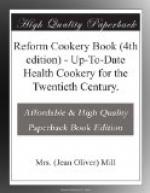This paste is most wholesome and economical. For a good-sized pie take 3/4lb. flour and 3 ozs. butter or Nut Butter. Put the flour in a basin. Bring the butter to boiling point with a teacupful water. Pour in among the flour, stirring all the time till thoroughly mixed, then knead well. When nearly cold take off about a third and make the rest into a ball, flatten and work up by hand till the case is about 2-1/2 inches high, and slightly narrower at the top—Melton-Mowbray shape. Slip on to greased oven-plate, and when quite firm, fill rather more than half-full with haricots, tomatoes, &c. Roll out the bit of paste remaining, cut out lid, wet the edges of it and the pie-case and pinch together. Brush all over with egg. Ornament with the trimmings, brush again and bake in good steady oven for at least three-quarters of an hour. When ready, pour in some more gravy, or if to be used cold, some dissolved savoury jelly.
Should there be difficulty at first in raising this entirely by hand, it might be moulded round a jar or round tin. Another way is to use a tart ring, but a very simple and handy way, which finds favour especially with children, is to make bridies. Divide the paste into ten or twelve pieces. Roll out a nice oval, put some savoury mixture on one half, wet edges with egg or water, press together and pinch into neat flutes, brush over with egg and bake.
Suet Paste.
Allow 3 ozs. vegetable suet to 8 ozs. flour. Chop the suet or run through nut-mill. Add to flour along with salt and pepper, and if liked, a little grated onion and chopped parsley. Make into a firm paste with water, which may have a little ketchup or “Extract” diluted in it.
This is, of course, for savoury pies, &c. If for sweet dishes—roly-poly, apple dumpling, &c.—omit all seasonings and add sugar and any flavouring preferred, such as clove, ginger, or cinnamon.
CAKES, SCONES, &c.
Only a few cakes, &c., are given here, as there are a number of excellent ones among the contributed recipes in last section, under heading of Bazaar contributions, and, besides, there is nothing about them peculiar to food reformers. Those who are studying wholesomeness and digestibility, however, will avoid as far as possible the use of chemicals for raising, and fats of doubtful purity such as hog’s lard. The injurious character of carbonate of soda, tartaric acid, &c., if used at all to excess, is now fully recognised, and those whose health is not quite normal should avoid them entirely. When such cannot be dispensed with, use very sparingly and in the exact quantities and proportions of acid and alkali, which will neutralise each other by converting into a gas which passes off in baking, if the oven, &c., is all right. But the latter point is rather a big and very essential “if,” and many cooks try to make up for deficiencies in mixing and firing, by putting in an extra allowance of baking powder. There is considerable




